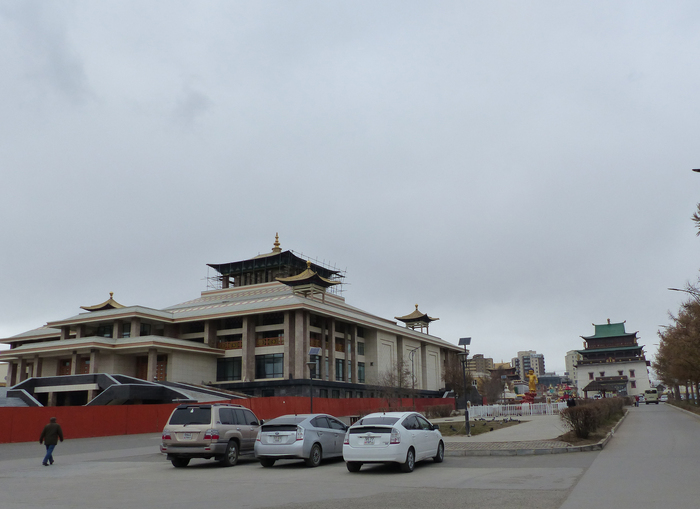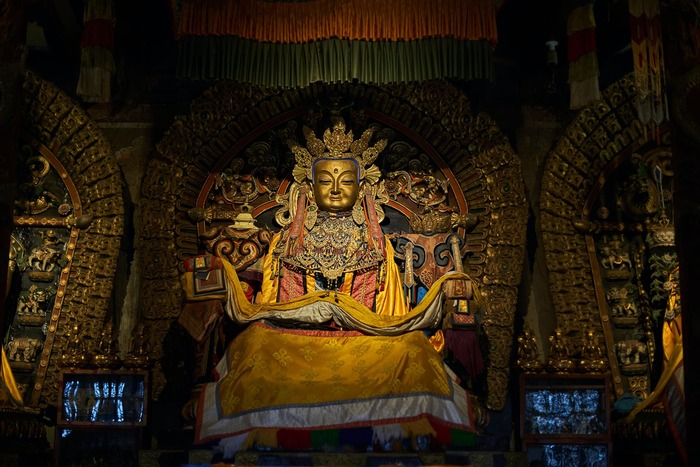
Main Projects and Improvements during the Most Recent Years
There has been great progress in recent years in the restoration of Buddhism in Mongolia.
In 2010, at the initiative of Günze Chimed and other students of the Ninth Bogdo Gegen, Gandantegchenlin Monastery (Tib. dga’-ldan theg-chen gling), referred to hereafter simply as “Gandan,” the main monastery of Ulaanbaatar, started the annual jod (chö) prayers (Khal. zod, Tib. gcod, “cutting” through ego-clinging), also called lüijin (Khal. lüijin, Tib. lus-sbyin, “offering the body”). She and the other students there had learned this practice from the Ninth Bogdo Gegen and follow his lineage. In December 2023, the annual prayers were held under the name Jod monlam (Tib. gcod smon-lam) the “Chö Prayer Festival,” or Jod yerööl or Lüijin yerööl, for the thirteenth time.
Several other annual rituals have also been reinstated or newly started at Gandan. For example, after the democratic change in 1999, the first tsam (Tib. ‘cham(s)) ritual dance was organized on the instructions of the old monks Sereeter and D. Danzan, an artist. A film was made of it with the aim of preserving the old traditions. Based on this, starting in 2015, Gandan revived the khüree tsam ritual dance, the “tsam where dancers move in a circle” or the “tsam from the monastic city, Ikh Khüree.” This has been held annually since then under the name danshig naadam khüree tsam. The dance is not held in the monastery but on the outskirts of Ulaanbaatar as it is also accompanied by traditional sport competitions. Its revival coincided with the 380th anniversary of the birth of the First Bogdo Gegen, Öndör Gegeen Zanabazar, and thus it became fused with the danshig rituals (Tib. brtan-bzhugs) for the long life of a spiritual master. The name danshig naadam khüree tsam includes the name of this ritual and the word naadam, which is the name of the annual traditional festival with the “three manly games.” Thus, in 2023, tsam has been revived and has been organized annually in three monasteries – Amarbayasgalant (since 2001), Dashchoilin (since 2002), and Gandan (since 2015).
In January 2017, His Holiness the Dalai Lama inaugurated the new Mongolian temple in Bodhgaya (Khal. Bod’ Gayaa or Dorjdan, Tib. rdo-rje gdan) India, where the Buddha achieved complete enlightenment. The temple was established by Gandan and is also named Gandantegchenlin.
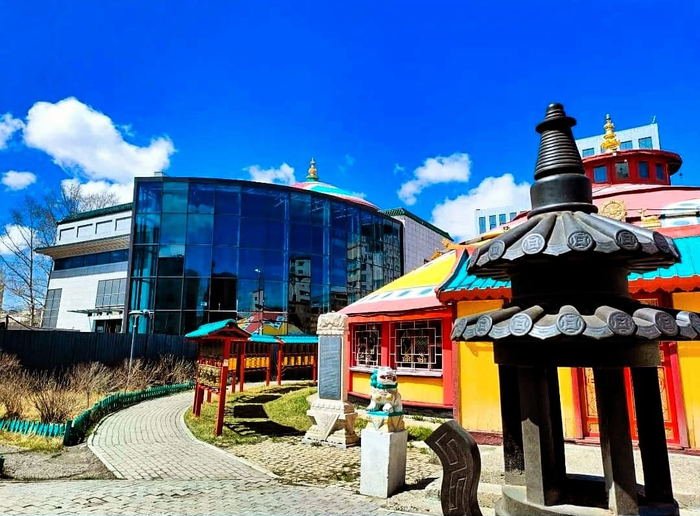
In 2018, Dashchoilin Monastery in Ulaanbaatar consecrated the grand Maitreya statue (Khal. Maidar, Tib. byams-pa) they had commissioned and its temple that once stood in the old Züün Khüree part of the monastic city. The monastery had lauched plans for rebuilding them in the 1990’s and had started fundraising in the early 2000’s. The statue is presently housed in a modern-style building, but one that keeps the traditional style of the Maitreya temples in Mongolia: it has a yurt-shaped dome above the head of the statue. The six-storey temple is to be opened in the spring of 2024. It has several halls and rooms for rituals, a library, classrooms, and expansive halls for meetings and conferences. The monastery currently operates in the two remaining temples of this monastic complex.
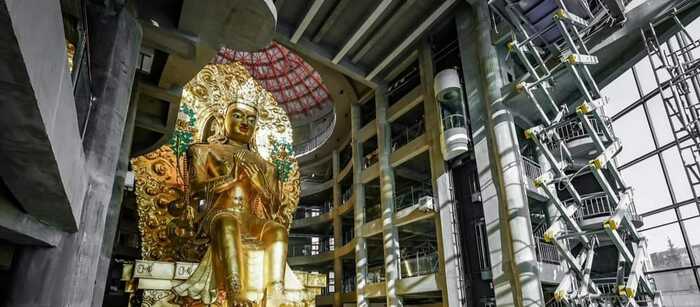
There is another project for building a huge, 54-meter-high Maitreya statue in Sergelen subprovince of Töw province 57 kilometres from Ulaanbaatar. This project, called “The great Maitreya project” (Khal. Ikh Maidar tösöl), is being undertaken independently from the monasteries.
In 2019, Gandan inaugurated its new main temple, named Battsagaan Tsogchin Dugan (Mong. batučaγan čoγčin duγang). “Battsagaan” means “Solid White” and “Tsogchin Dugan” (Tib. tshogs-chen ‘du-khang) means “Great Assembly Hall.” Several large events and regular scientific conferences are already being held there. The new Dashchoilin temple will likewise host similar events.
Also in 2019, on the initiative of the Gandan abbot of that time, D. Choijamts, one of the four annual great Buddhist festival days – the one that commemorates Buddha’s birth, enlightenment, and passing away – became an official public holiday. The day was decreed a public holiday by the Mongolian Parliament under the name “The great festival day of the Buddha” (Khal. Burkhan bagshyn ikh düichen ödör). This name actually applies to any of these four great days but is now also used as the official name of this public holiday. It is celebrated on the fifteenth, or full moon day of the first summer month. Since 2019, a huge procession has been held on that day with monks from different monasteries participating. Various teachings are given and rituals are conducted in the main square, now called “Chinggis Square.” This festival day commemorating the Buddha becoming a public holiday is significant in that it indicates state acknowledgement of Buddhism despite Buddhism not being the official state religion.
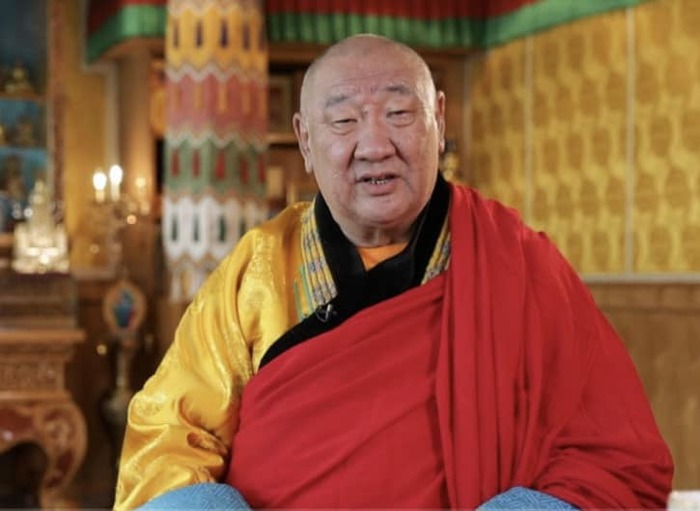
In addition to all these recent developments and new projects, 2023 has seen the most important changes. In this year, the Tenth Bogdo Gegen (Khal. bogd, or bogd gegeen), the traditional head of Mongolian Buddhism, was named and brought to Mongolia. In addition, D. Choijamts, the head abbot of Gandan and of all Mongolian Buddhists, retired after thirty-one years in office.
The Installation of the Tenth Bogdo Gegen
On March 8, 2023, being the third day of the first spring month of the water hare year (Khal. usan tuulai jiliin shinii 3), His Holiness the Dalai Lama introduced to the public the new Mongolian head lama (Khal. mongolyn burkhany shashny tergüün), the Tenth Bogdo Gegen, or Jebtsundampa Khutugtu (Khal. jewzündamba khutagt), in Dharamsala, India. His titles and all terms referring to him will be used hereafter in this article in Modern Khalkha Mongolian form. Since the death of the Ninth Bogd in 2012, this announcement was much awaited by Mongolian Buddhists. The Ninth Bogd was Tibetan, but the new Tenth Bogd is a Mongolian child. The fact that, after 265 years since the 1758 Manchu order decreeing that all future reincarnations must be found in Tibet, the position is finally filled by a Mongolian child is of great importance to the Mongols.
The Tenth Bogd was publicly introduced before starting the preliminary practices on the first day of a Chakrasamvara (Khal. Demchig / Demchog, Tib. ’khor-lo bde-mchog, or ’khor-lo sdom-pa, Skt. Cakrasaṃvara) empowerment. The empowerment was for the Chakrasamvara practices according to the lineage of the mahasiddha (Khal. düwchin, Tib. grub-chen, Skt. mahāsiddha, “greatly accomplished tantric practitioner”) Krishnacharya (Khal. (Demchog) nagwo(wa)chopa / krishnacharyaa, or Ikh khar yawdalt, Tib. Nag-po (-pa) spyod-pa, Skt. Kṛṣṇācārya). As is usual, a large number of Mongolians, about 600, attended the empowerment. It was held at the request of Gandantegchenlin Monastery and several Tibetan tulkus (Tib. sprul-sku, incarnate lama). The announcement, during which the Dalai Lama pointed to the Bogd sitting nearby, was the following: “We have the reincarnation of the Khalkha Jebtsundampa Rinpoche of Mongolia with us today. His predecessors had a close association with the Krishnacharya lineage of Chakrasamvara. One of them established a monastery in Mongolia dedicated to its practice. So, his being here today is quite auspicious.”
The close connection mentioned by the Dalai Lama refers to the fact that one of the biographies of Krishnacharya was written by Tāranātha. Tāranātha is recognized as a reincarnation of Krishnacharya, while the Jebtsundampa Khutugtu, or Bogds, are recognized as the reincarnations of Tāranātha. The verb todruulakh used in Mongolian for the act of identifying a next reincarnation means literally “to clarify, to determine,” while the verb khoid dür todruulakh means “to identify, to name” such a child.
The boy named as the tenth reincarnation was born in the USA in 2015 and thus is eight years old as of 2023, has an identical twin and holds dual US-Mongolian citizenship. He participated at the empowerment together with his family, which included his twin brother, his father Ch. Altannar (a university professor of mathematics), his mother N. Mönkhnasan (an American university graduate and CEO of the Monpolymet Group, a major mining and cement conglomerate in Mongolia) and his grandmother Ts. Garamjaw (a former parliament member, a successful businesswoman, the founder of the Monpolymet Group and one of the main patrons of the Ninth Bogd). Possibly as his parent’s precautionary decision to protect him, it is only known that he is one of the twins without it being clarified which one of the two he is. The twins are called A. Aguidai and A. Achiltai – in both cases, A. is short for Altannaryn, indicating that they are the sons of Ch. Altannar. For the same precautionary reason, the boys do not appear in public without each other and receive the same education, both secular and religious.
The Tenth Bogd received the name Danzanjambalchoijiwanchüg (Tib. bstan-’dzin ’jam-dpal chos-kyi dbang-phyug) from the Dalai Lama. During the days immediately following the announcement, ceremonies reciting the long-life prayer for the Tenth Bogd were held in Mongolian monasteries and Buddhist centers, and even in Tibetan monasteries and monastic schools in India that have a considerable Mongolian lama community. Note that all monastics are called “lama” in Mongolia.
It was known for a long time before the announcement that the new reincarnation is Mongolian. On November 23, 2016, during the Dalai Lama’s last visit to Mongolia, His Holiness had already announced that the Tenth Bogd had been born in a Mongolian family. On that occasion, His Holiness added that due to his young age there was no need to name him as it would be difficult to enthrone him at such a young age.
After this visit of His Holiness to Mongolia, the relationship between Mongolia and China turned worse as China closed border crossings, imposed heavy tariffs, and canceled all official meetings for a while. This made any further visit of the Dalai Lama to Mongolia impossible.
Even before the Dalai Lama’s 2016 announcement, the Ninth Bogd himself had also declared in his will that he would be reborn as a Mongolian child. He added that the Dalai Lama would recognize the new reincarnation and that, as the child grew up, he would not partake in state or political affairs, only in religious ones. A sentence in the Ninth Bogd’s Tibetan language biography even indicates a promise he made shortly before his death for a future “visit” to the home or family of Ts. Garamjaw, the grandmother of the Tenth Bogd. This reference to the family in which he would be reborn was widely quoted after the announcement of the new reincarnation.
Nevertheless, eleven children had been chosen for further investigation as candidates for being chosen as the reincarnation from among several ten thousand names that had initially been considered. But only one – Ts. Garamjaw’s grandson – had recognized the belongings and ritual implements of the Ninth Bogd, his predecessor, from among similar objects, which is the traditional method for identifying a reincarnate lama.
It took a long time, however, until 2023, before the new reincarnation was finally introduced to the public by the Dalai Lama. It is said that the new main temple at Gandan, inaugurated on September 9, 2019, after years of construction, was built for the purpose of the enthronement of the Tenth Bogd in preparation for him being brought to and educated in Mongolia.
In the Mongolian language, the Tenth Bogd is often mentioned by the honorific title Naran gerelt tümen nast (Bright as the Sun, Long-living One). This title is also said to be parallel to his parents’ names, Altannar (Golden Sun) and Mönkhnasan (Eternal Life). Mongolian names have a meaning and often consist of two parts, with each usually having a meaning. This honorary form of address is used in its longer versions as well, such as Naran gerelt tümen nast oroin deed, Ochirdar’ bogd gegeen (Bright as the Sun, Long-living One, Most Superior Vajradhara Bogd Gegeen), Oroin deed tümen nast, Ochirdar’ getlgegch arawdugaar bogd jewzündamba (Most Superior, Bright as the Sun, Long-living One, Vajradhara Protector, Tenth Bogd Jebtsundampa), or even Naran gerelt tümen nast oroin deed, Ochirdar’ burkhany khuwilgaan arawdugaar bogd jewzündamba khutagt (Bright as the Sun, Long-living One, Most Superior, Incarnation of Vajradhara Buddha, Tenth Bogd Jebtsundampa Khutugtu). These longer honorific titles include that he is considered to be the manifestation of Vajradhara (Khal. Ochirdar’, Tib. rdo-rje ’chang), the primordial Buddha, or Adi-Buddha.
After the introduction of the Tenth Bogd, an early twentieth-century folk song was mentioned widely in the news about him. The song originates from the period right after the death of the Eighth Bogd, or Bogdo Khan (Khal. bogd khan) in 1924, the search for whose reincarnation was banned in Mongolia for a long time. The content of the song portends the installations of both the Ninth and the Tenth Bogds. The relevant line in the song is, “We welcome our bright-bodied Bogd in the year of the hare.”
There are two versions of this verse in Mongolian, “Tungalag dürtei bogdygoo / Tuulai jildee zalna daa” and “Tunamal dürtei bogdygoo / Tuulai jildee zalna daa.” They differ only in the first word, tungalag meaning “clear, bright” and tunamal meaning “translucent, clear.” Thus, the two variants, which both follow the alliteration rule of Mongolian poetry where lines must begin with the same letter, have basically the same meaning.
The verb zalakh, which appears in the verse in its inflection as zalna, means “to invite, greet, welcome.” This verb is used in the Mongolian language for saluting or receiving a master or teacher, or for placing a new image or set of scriptures in a temple, and so forth. It is also found in the term sentiid zalakh (“enthroning,” literally “inviting to the lion throne”). The first part of the expression is the Mongolian transliteration of the Tibetan word seng-khri, “lion throne,” which is obviously the meaning intended in the case of the Bogds.
This verse was seen as lines of hope at the time of their composition, but later the reference to welcoming the new Bogd in the year of the hare came true for both the ninth and the tenth reincarnations. In reference to the Ninth Bogd, after his recognition by the Dalai Lama and enthronment in Dharamsala, his enthronment in Mongolia in 1999 and official acknowledgement in Mongolia as the head of Mongolian Buddhism in 2011 both took place in a year of the hare. In the Tibeto-Mongolian calendar, animal years repeat in a twelve-year cycle. The Tenth Bogd was recognized publicly in 2023, also a year of the hare.
Soon after his public introduction in India, the Tenth Bogd arrived in Mongolia. His birthday, on May 4, became a main religious festival day (Khal. düitsen/düichen ödör, Tib. dus-chen) as part of the annual ceremonial calendar. Accordingly, a ritual was held in Gandan monastery’s new main assembly hall, the Battsagaan Tsogchin Dugan. It was one of the first rituals at which the Tenth Bogd appeared in person, together with his twin. Since then, they have been seen together at different important rituals.
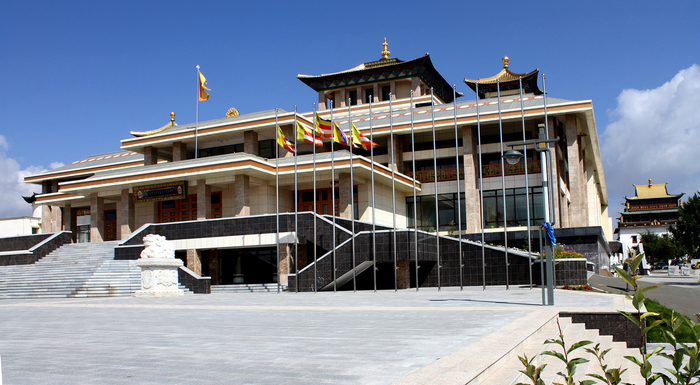
On his parent’s decision, the young Tenth Bogd, together with his twin, continues his regular secular education, although he also receives parallel religious training from lama teachers appointed from Gandan. These include the new head lama as well as two Mongolian tulkus recognized after the democratic change, Manzshir Khutagt and Lamyn Gegeenten. It is not yet known if he will be trained for a longer period at one of the Tibetan monastic schools in India, as is usual for Mongolian tulkus and for many other Mongolian lamas. Currently, it seems that his parent’s opinion – with Gandan’s approval – is that, when he turns eighteen, he himself should decide whether he takes monk vows and whether he takes on his customary duties as Bogd. Thus, it seems that only after reaching adulthood will he have an active spiritual role. It is hoped, however, that he will accept the traditional leadership position in Mongolia working in the traditional duality with the head abbot of Gandan.
Mongolia today is a free country with the free practice of religion. Thus, the installation of the Bogd is exclusively an internal affair of the Buddhist establishment. However, the strong traditional connection between Mongolian Buddhism and Tibet, and the fact that it was the Dalai Lama who recognized the new reincarnation, may lead to serious geopolitical consequences in the relations between Mongolia and China. In the past, Mongolia has already suffered severe reactions from China to its connections with Tibetan Buddhism.
The person filling the position of Bogd, the Jebtsundampa Khutugtu, is often mentioned as the third most important figure within the Gelug (Tib. dge-lugs) school of Tibetan Buddhism. He holds the rank most important after the Dalai Lama and Panchen Lama. At the same time, of course, all the other Tibetan Buddhist schools have their own heirarchies. The importance of the Bogd is even greater today. Since Tibet’s independence has long been lost, Mongolia is one of the main countries where Tibetan Buddhism is still practiced freely and, where, since the time of Öndör Gegeen Zanabazar in the seventeenth century, mainly the Gelug school is present. The importance of the Bogd might even grow greater due to the old age of the Dalai Lama and the position of the Panchen Lama being unfilled – for example, he supposedly could have a role in the recognition of the next Dalai Lama. The then only six-year-old eleventh incarnation of the Panchen Lama, who would traditionally play this role, was kidnapped only three days after his installation in 1995 and has not been heard of since.
No official statement has been issued by the Mongolian government about the arrival of the Tenth Bogd in Mongolia and his future role. This might be due to the political tension with China, but also partly due to the fact that the Bogd is still very young. Buddhism is not the official state religion in Mongolia, although the majority of religious people are Buddhist, and Buddhism is a main keystone of the Mongolian national identity. Nevertheless, the official position of Buddhism was established after the democratic change thanks to the efforts of D. Choijamts, the head lama of Gandan, who represented Buddhism at the time. It is stated in the related law, “In Mongolia, the relation between the State and the monasteries is based on the principle of ‘the State respects its religion, religion respects its State’” (Khal. Mongol uls dakh’ tör, süm khiidiin khariltsaa tör n’ shashnaa khündetgej, shashin n’ töröö deedlekh zarchimd ündeslene). The same law states that the president is responsible for questions related to religion.
It was based on this law that, in 2009, upon the request of the Gandan head abbot, the then president invited the Ninth Bogd to Mongolia, granted him Mongolian citizenship, and officially appointed him as head of Mongolian Buddhism. It was also based on the same principle that, in the summer of 2021, the next President, Kh. Battulga, officially granted the rank Twenty-ninth Khamba Nomun Khan (Tib. mkhan-po chos-rgyal, “Abbot King of the Dharma Teachings”) to D. Choijamts. The title had previously been granted to the other abbots of Gandan since 1944 by the Council of the Head Lamas of Mongolian Buddhists (Khal. mongolyn burkhany shahsintnii tergüün lam naryn zöwlöliin khural) and in the future, would also be automatically granted to Choijamts’ successors in the position of Gandan abbot. Based on the same law, the current president could strengthen the position of the Tenth Bogd by appointing him officially. However, his enthronement is only planned later, and we will only see then how his acceptance by the State will turn out.
The Installation of the Thirtieth Head Abbot of Gandan, D. Jawzandorj
On November 1, 2023, D. Choijsamts tendered his resignation from his position as head abbot of Gandan (Khal. tergüün ikh khamba, “great head abbot,” also known as deed khamba, “highest abbot,” the last word in the expression being Tib. mkhan-po, abbot). He retired after having held this position as head abbot not only of Gandan but also of all Mongolian Buddhists for thirty-one years (1992-2023).
Born in 1951, D. Choijamts holds the monastic degree of Kachu (Khal. gawj, Tib. dka'-bcu), a degree awarded after an examination on the ten difficult Buddhist texts, being Indian texts on the five major subjects of the monastic education system and their commentaries. Before holding the position of head abbot, he had served for four years as vice-abbot (Khal. ded khamba) and also as main lama (Khal. daa lam, a high rank in monasteries), serving all in all for thirty-six years.
Upon resigning, D. Choijamts named D. Jawzandorj as his successor. He was accordingly appointed that same day at the decision of Gandan’s authorities. D. Choijamts had the title Twenty-ninth Khamba Nomun Khan and thus the new abbot bears the title Thirtieth Khamba Nomun Khan. His enthronment (Khal. shireend zalakh yoslol, “the ceremony of welcoming to the throne”) as Gandan head abbot was held in the new Gandan main assembly hall, the Battsagaan Tsogchin Dugan, on November 18, 2023, the fifth day of the first winter month of the water hare year of the seventeenth sixty-year cycle. The Tenth Bogd also participated at the event and fulfilled his traditional duties.
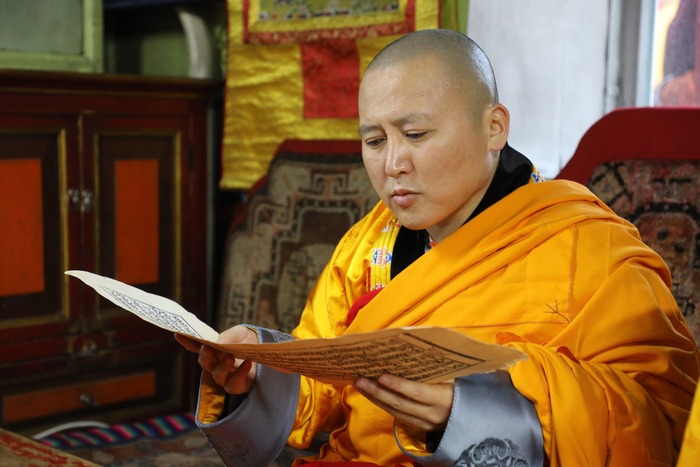
D. Jawzandorj holds the monastic degree of Geshe Lharampa (Khal. gewsh lkhaaramba, Tib. dge- bshes lha-rams-pa), the highest academic degree in the Buddhist monastic education system. As the first Mongolian lama to receive the Lharampa degree after the revival, he is therefore highly esteemed. He is also a fully ordained monk, which is still rare among Mongolian lamas. All these qualities give hope for the further restrengthening of Buddhist education and ethical discipline in Mongolia in the coming years.
Born in 1980, D. Jawzandorj joined Erdenemadal monastery in Sükhbaatar province center in 1991 and received his genen (Tib. dge-bsnyen, Skt. upāsaka) lay ordination in 1992 from the then Gandan abbot, the Twenty-eighth Khamba Nomun Khan, T. Damdinsüren. In 1993, he joined Dashchoilin monastery, where he served as unzad (Tib. dbu-mdzad), chant master. While there, he also studied subjects such as philosophy from various Gandan lamas.
In 1998, he went on to study at Gomang College (Khal. goman dastan, Tib. sgo-mang grwa-tshang) of Drepung Monastery (Khal. braiwün/drepung, Tib. ’bras-spungs) in India. There, he received his getsel (Tib. dge-tshul, Skt. śramaṇera) novice monk ordination in 1998 and gelen (Tib. dge-slong, Skt. bhikṣu) full monk ordination in 2001 from His Holiness the Dalai Lama.
He continued his studies at Drepung Gomang till 2005. There, he finished the study of the five major topics (being five major Indian texts) of the Gelug monastic education system in the required order and proved his knowledge of each of them at formal debates between 2000 and 2012. He had many great achievements during his studies, such as gaining several times the title of the monk who memorized the most texts in the monastic school, getting first place in ten of the monastic classes (Khal. zindaa, Tib. ’dzin-grwa) and second place in two classes.
Later, during the six years of the more advanced Lharampa course of study, he won first place in the annual exams four times and ranked second twice. In 2017, after sixteen years, all in all, of monastic studies, he even achieved the best results from among 1000 monks at the final exams and thus he gained the exceptional title of “Angidampa Lharampa” (Khal. angi dambyn/danbyn lkhaaramba, or tergüülekh zergiin lkhaaramba, ’lkhaaramba, Tib. ang-gi dam-pa lha-ram-pa), “First Rank Lharampa.” Even more important from the point of view of Mongolian Buddhism is that, with this award, he became the first Mongolian to earn this title from the Tibetan monasteries after the revival of Buddhism, actually ever since 1921. Since his achievement, however, several other Mongolian lamas have earned the same title from Gandan and Dashchoilin monasteries after their almost two decades of studies in India.
In 2018, after finishing a year’s study in Gyuto, the Upper Tantric College (Khal. jüddod dastan, Tib. rgyud-stod grwa-tshang) in India, he finished in first place in the exams on tantric studies. In 2019, he finished in third place at the Ngagrampa (Khal. agramba or agrimba, Tib. sngags-rams-pa) exam there. Later in 2019, he returned to Mongolia for a short while. In 2023, back in India, he finished three years’ of further tantric studies at Drepung Gomang College, where he finished in first place in the final exams, both in debate (Khal. metgeltseen or nom khayiltsakh, Tib. rtsod-lan, rtsod-pa) and at the written exam.
Since he started teaching in 2002, D. Jawzandorj has prepared many hundreds of lamas for their exams, among them several young Mongolian tulkus who bear the titles Khuwilgaan, Khutagt or Gegeen in Mongolian. These include Yegüzer Khutagt Danzanluwsanwanjil, Sraidorj Nomun Khan Luwsandambiijaltsan, Mergen Bandida Danzanjam’yanlodoi, and two lamas holding the Kachu degree. Next year, it is hoped that the first of his students will earn the Lharampa degree and that many others will follow. Due to these activities and his numerous public teachings, he was honorifically given the name “Mongolian teacher” (Khal. mongol bagsh) by his Indian, Tibetan and Mongolian lama students and has become known widely by this name in Mongolia. He has published several books in Mongolian and also composes texts in Tibetan. Many of his teachings are also available online.
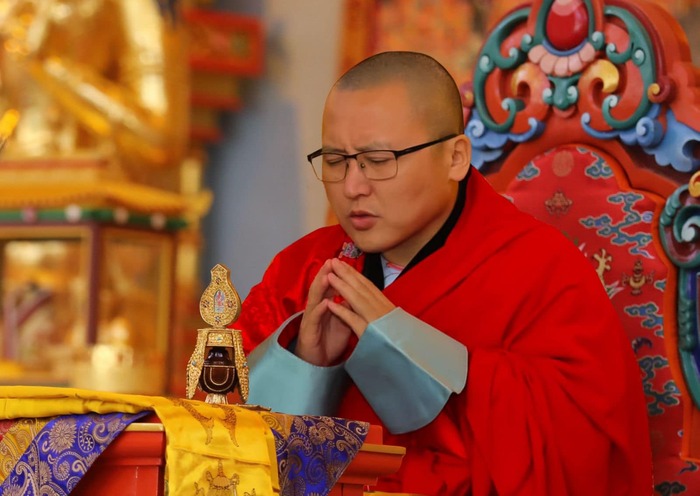
From 2011, D. Jawzandorj has served as abbot at Erdenemandal Monastery in Sükhbaatar province and, starting in 2012, he has been interpreting for His Holiness the Dalai Lama at various initiations and teachings, including his last visit to Mongolia in 2016. In 2013, he established the Sumadi Girdi Center, named after Tsongkhapa’s ordination name (Tib. blo-bzang grags-pa, Skt. sumatīkirti). From 2020, he has also been teaching at the Zanabazar Buddhist College of Gandan (Khal. Öndör gegeen Zanabazaryn neremjit (mongolyn) Burkhany Shashny Deed Surguul’), mainly Tsongkhapa’s lamrim graded path commentaries (Khal. bod’ möriin zereg, Tib. lam-rim). On September 22, 2023, D. Choijamts appointed him to teach Buddhist philosophy to the Tenth Bogd as well.
D. Jawzandorj’s backgound and exceptional achievments give hope that there will be further progress in the reestablishment of Buddhism and its monasteries in Mongolia. In fact, D. Choijamts himself also expressed the opinion that, in light of the long history of Mongolian Buddhism, the initial period of reinstating Buddhism is over, where the revival was led by those lamas who had emerged during the communist period with the partial operation of Gandan and was supported during the first decade by the old surviving lamas. Now is the time for the new generation – those who were educated after the revival and had the possibility to master the teachings on an even higher level in India – to take their places and bring new improvements.
In fact, D. Choijamts himself played a major role in reviving Buddhism in Mongolia when the new democratic society and the status of religion within it was only being formed and its monasteries were newly reopened and rebuilt. It was during the first following decades that the traditional monastic education was restarted in these monasteries and traditional institutions were reinstated.
After his retirement, D. Choijamts temporarily has kept his positions in three international Buddhist organizations before also handing them over within the next few years. These organizations include the Asian Buddhist Conference for Peace (ABCP, Khal. Azi Buddistuudyn Enkh Taiwany Baga Khural) and the International Buddhist Confederation (IBC, Khal. Olon Ulsyn Burkhany Shashintnuudyn Kholboo).
Soon after the enthronement of the new Gandan abbot, S. Gantömör was appointed as vice-abbot (Khal. ded khamba). He is a holder of the Kachu degree and held the position of shunlaiw (Tib. gzhung-lugs-pa, follower of the scriptural system), the head of Dashchoimbel (Tib. bkra-shis chos-’phel) philosophical monastic college of Gandan. The ritual for his installation was held on December 15, 2023. The position had been vacant for a short while beforehand.
